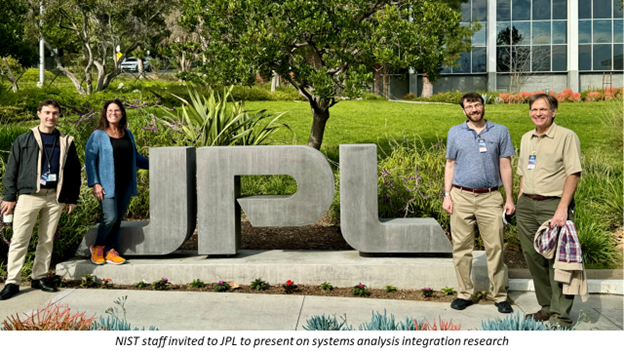NIST Researchers Present to NASA’s Jet Propulsion Laboratory on Systems Analysis Integration

NIST’s Systems Analysis Integration (SAI) project was invited to present its research to the NASA Jet Propulsion Laboratory (JPL) Systems Engineering Solutions Group and members of the Open Model Based Engineering Environment project (OpenMBEE), an open-source effort led by JPL and Boeing to deliver major improvements in systems engineering software. The SAI project is part of the Smart Connected Manufacturing Systems Group, led by Allison Barnard Feeney. The project increases efficiency of engineering processes by integrating a variety of automated analyses with the Systems Modeling Language (SysML), the most widely used modeling language for systems engineering, in order to reliably share system specifications and analysis results among project contributors. JPL and NIST have collaborated on systems analysis integration for over ten years, contributing research results to standards development at the Object Management Group (OMG), which publishes SysML.
NIST SAI staff presented and discussed several areas of analysis integration over 2 days at JPL:
- Charles Manion showed his work on expanding capabilities of the SysML Extension for Physical Interaction and Signal Flow Simulation (SysPhS), a standard published by OMG for modeling time-based (1D) physical and signal behavior in complex systems designs, as well as translating models to two well-known 1D simulation platforms. He covered three new SysPhS physical component libraries, along with examples applying them to manufacturing system modeling. Manion automatically translated and simulated the examples on 1D simulation platforms using software developed by NIST’s Raphael Barbau.
- Raphael Barbau reported on his extension of SysML for logistics modeling and analysis (SysLMA), soon to be submitted for standardization at OMG. SysLMA describes logistics systems at multiple levels of detail, and defines mappings to widely used analysis platforms for multi-commodity flow optimization, queuing analysis, and discrete event simulation. Barbau demonstrated his software for automatically translating SysLMA to analysis platforms, performing analysis, and producing results as feedback to system design.
- Conrad Bock, SAI project leader, outlined his research on adapting SysML behavior models for logical analysis, Ontological Behavior Modeling (OBM), to give a mathematical foundation for expressing system behavior. It combines temporal interval relations and SysML’s capabilities for assembling systems to produce an engineering-friendly way of constructing behavior models that are logically grounded. This significantly reduces the complication of SysML behavior modeling, making it easier to learn and build tool support. It is included an upcoming major update to SysML by OMG.
- Barbau also described his software for verifying OBM by automatic translation to Satisfiability Modulo Theory (SMT) solvers, via a widely used file format for stating these kind of logical problems. He demonstrated it on OBM examples, translating and solving them on an open-source logical solver to produce valid executions of the behaviors or to show they could not be executed properly according to the behavior models.
- Jeremy Doerr of the Georgia Tech Research Institute covered related work developed under a NIST grant translating OBM to Alloy Analyzer, a textual language and solver for Boolean Satisfiability (SAT) problems. He described the language and how to translate OBM examples similar to Barbau’s above.
- Bock concluded by reviewing his research on four dimensional systems requirements modeling, an enhancement of OBM to specify behavior of systems over time and space in an integrated framework. It is also included the upcoming major update to SysML, enabling spatial requirements to be modeled without initially committing to specific shapes, then later refining them topologically and geometrically.
JPL, Boeing, and other attendees provided feedback on the presentations and initiated plans for more interaction and collaboration.

